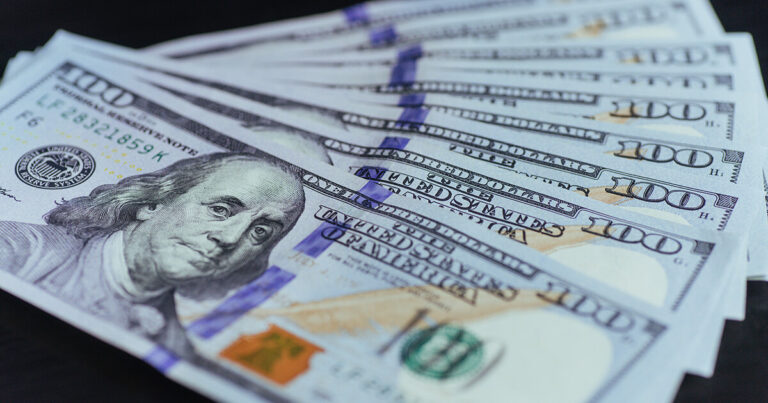
A mixed week for the G7 forex currency market as positive sentiment boosted demand for risk assets. As a result, the US dollar traded in a firm range and closed comfortably in a green territory while the Japanese Yen continued to drop.
Commodity-related currencies emerged as winners, with the Australian dollar leading the way. The Aussie dollar benefited significantly from surging commodity prices and rate hikes expectations.
High Impact News In The Forex Currency Market

During the week, economic data and Russia’s shelling of Ukraine boosted the dollar and commodity-related currencies.
Economic Data
Economic updates, particularly inflation, rate hikes expectations, supply chain, and treasury yields, favored the American dollar and commodity-related assets.
Global benchmark treasury yields continue to spike to new highs. For instance, the 10-year treasury yield in Germany hit the highest level since 2018, while the 10-year in the UK reached new highs since 2016. US 10-year yields also hit a new high of 2.5 percent, the highest rate since 2019.
Economic reports show supply shortages continue to hamper manufacturing and construction sectors. While global price bites, inflation in the UK soared to an all-time high in thirty years.
Analysts believe the UK’s inflation is not slowing down soon, as it rises to 6.2 percent in the week. Higher commodity and energy prices are already reverberating worldwide, affecting prices in all sectors. And to curb the high inflation, G7 nations are removing economic stimulus and starting rate hikes.
But Japan, as reflected in the yen’s miserable performance, maintained zero level rates. The Fed’s hawkish comments on Monday drove the market higher. Powell said the Fed was ready to hike rates faster if needed, and the market could see up to fifty basis points hikes in the coming months.
Geopolitics Tensions
The geopolitical scene was quite interesting this week. Russia continues to shell Ukraine, killing civilians and destroying infrastructure. However, Putin’s plans to take Ukraine easily seem to fail as Ukrainians put up fierce resistance to defend their country.
Russian soldiers retreated in some parts of Kyiv as Ukraine soldiers put up a spirited fight. A ceasefire meeting earlier in the week between Ukraine and Russia negotiators ended without success.
On Monday, talks ended amidst Russia, making outrageous demands that Ukraine must put down weapons in Mariupol city. Ukraine rejected Russia’s demands, terming them unacceptable.
US and NATO agreed to send troops and weapons to the eastern border to prevent Russian soldiers from advancing further. In addition, the western alliance agreed to reduce reliance on Russian oil and natural gas.
Russia president Vladimir Putin wants ‘unfriendly’ nations to buy Russian oil and gas in roubles. Further, Putin said he could permit ‘friendly’ nations to pay oil and gas in bitcoin. The US administration sanctioned over three hundred Russian oligarchs and the Russian central bank from accessing gold reserves.
America shifted its focus away from the Ukraine crisis and China to address Iran’s nuclear deal in the week. According to Antony Blinken, US secretary of state, “America and Israel are committed to stopping Iran from developing nuclear weapons.” Therefore, returning to the full implementation of the nuclear deal is the best way to keep Iran’s nuclear program in check.
Long Term Oil Price Forecast
During the week, oil prices reached 117 dollars per barrel before retreating. Early in the week, the falling odds of a ceasefire in the Ukraine crisis boosted the long term oil price forecast.
On Monday, Ukraine declined Russia’s demands for Ukrainian soldiers to lay down arms in Mariupol city. The oil price spiked on Friday following an attack on a Saudi energy facility.
Economic Review and performance of G7 currencies
Table: g7 currencies performance summary
| Currency pair | 19th Mar 2022 | 25th Mar 2022 | Average price | Percentage change | Remarks |
| USD | 98.499 | 98.822 | 98.652 | 0.606 | increase |
| GBPUSD | 1.3165 | 1.3188 | 1.3200 | 0.0607 | increase |
| EURUSD | 1.1014 | 1.0981 | 1.1004 | -0.6694 | drop |
| USDCHF | 0.9335 | 0.9303 | 0.9315 | -0.0967 | drop |
| USDJPY | 119.47 | 122.06 | 121.16 | 2.43 | increase |
| USDCAD | 1.2592 | 1.2473 | 1.2544 | -1.0236 | drop |
| AUDUSD | 0.700 | 0.7512 | 0.7478 | 1.3082 | increase |
| NZDUSD | 0.6884 | 0.6971 | 0.6951 | 0.9851 | increase |
US Dollar Strength
Dollar gains for the sixth time in seven weeks as it reverses previous losses. Following a loss of 0.90 percent in the last week, it gained 0.57 percent to 98.789 this week. Fed Chair Powell, poor economic updates, and the Ukraine crisis delivered us dollar strength in the week.
America posted mixed economic data. Positive news from the labor market and the private sector lifted the greenback. But consumer sentiment and core durable goods weighed on it.
Preliminary figures show the US service index rose to 58.9 from 56.5 and manufacturing index shot to 58.5 from 57.3. Weekly jobless claims boost the dollar, according to forex market data. The claims fell to 187 thousand, the lowest level since Sept 1969.
Consumer sentiment and core durable goods declined unexpectedly.
GBP USD Forex Rate
The pound appreciated by 0.03 percent to close at 1.3182 following a previous 1.08 percentage growth. Inflation, retail sales, and private sector performance predominantly drove the UK’s forex currency market. The stats were a mixed bag for gbp usd forex rate.
Inflationary pressures continue to heat, hurting consumer spending. Forex market reports show consumer spending in the UK declined in February. A surge in service industry activity uplifted gbp usd exchange rate.
Euro To Dollar Forecast
The euro fell by 0.62 percent to 1.0983, rising by over 1.27 percent in the previous week. On Thursday, France, Germany, and the Eurozone released their preliminary private-sector data. The private sector’s activity exceeded projections but at a slower pace.
Eurozone’s composite index fell to 54.5 from 55.5, the lowest in two months. Manufacturing sector weighed on private sector activity. The Eurozone’s manufacturing index eased to 57.0, the lowest level in 14 months.
German business sentiment report on Friday weighed on the euro to dollar forecast. Forex currency market reports show the business climate index declined to 90.8 from 98.5. The expectations index, however, fell to 85.1 from 98.4.
The ECB’s Economic Bulletin further pressured the euro’s value. ECB noted upside risks to the economy and uncertainty ahead.
Foreign Exchange USD To CAD
In recent weeks, the Loonie has strengthened. This week it rose by one percent to 1.2477 after boosting by over one percent last week. Canada released few economic data that slightly impacted foreign exchange usd to cad.
However, Canada’s monthly Industrial Product Price Index heightened by over three percent in February. Also, the price index for raw materials increased by six percent. Oil prices rose during the week, providing much-needed support for the Canadian dollar.
Exchange Rate Swiss Franc To Dollar
Swiss franc rallied by 0.0967 percent against the dollar, after gaining 0.3638 percent previously. Although the Swiss Franc has become more expensive, the Swiss National Bank maintained its interest rate at three-quarters percent negative.
Swiss franc received support from fed’s hawkish remarks.
Asia-Pacific Forex Currency Market

While the Aussie and kiwi dollars enjoyed a bullish week, Japanese yen hit its lowest level in six years.
AUD Currency Index
Australian dollar appreciated by 1.35 percent to 0.6972, emerging as the week’s winner. Australia did not post any economic data to support its currency. So the aud currency index rallied on positive developments in the Ukraine crisis.
First, the Russian invasion pushed commodities higher. Second, hopes for a peaceful resolution boosted the Aussie dollar. Besides the Russian invasion into Ukraine, the Australian dollar found additional support from rate hike expectations.
NZD Currency Index
New Zealand dollar rallied yet again by nearly one percent, coming hot on the heels of the Australian dollar. Though positive, trade data and consumer sentiment had a muted impact on the nzd currency index.
The monthly trade data deficit narrowed, but the deficit widened to over eight billion New Zealand dollars yearly. Consumer sentiment declined in the first quarter. Market surveys reveal supply chain interruptions pointing to more uncertainty ahead.
Japan US Exchange Rate
Yen emerged as the week’s forex currency market biggest loser. It slid by nearly two and a half percent to 122.05 against the dollar. In the week before, it lost 1.60 percent to the dollar.
Private sector activity and inflation figures predominantly influenced Japan us exchange rate. Though positively inclined, the numbers failed to support the yen. Tokyo’s annualized inflation rate rose from half percent to over three-quarter percent. And services sector activities heightened to 48.7 from 44.2.
Manufacturing sector activity ticked up but did not uplift yen currency from the red zone. According to the Bank of Japan, the Russian invasion of Ukraine poses a significant risk to Japan’s economy.
Japanese BOJ Governor Kuroda reiterated Japan’s position to keep monetary policy easy on Tuesday. Japan’s position contradicts other G7 nations that have raised interest rates and expect more hikes this year.
Week Ahead
In the coming week, we expect the following fundamentals to drive the forex market;
- Progress in the Russia/Ukraine ceasefire talks
- Interest rates hikes
- OPEC meeting
- Economic updates
Last week, geopolitical tension and economic data largely influenced the forex currency market. The Ukraine crisis escalated as ceasefire talks failed, consumer prices continued to rise and the G7 nations instituted monetary policies to curb the inflation.
Will Russia and Ukraine finally reach a ceasefire deal this week?
Don’t miss the upcoming analysis!





